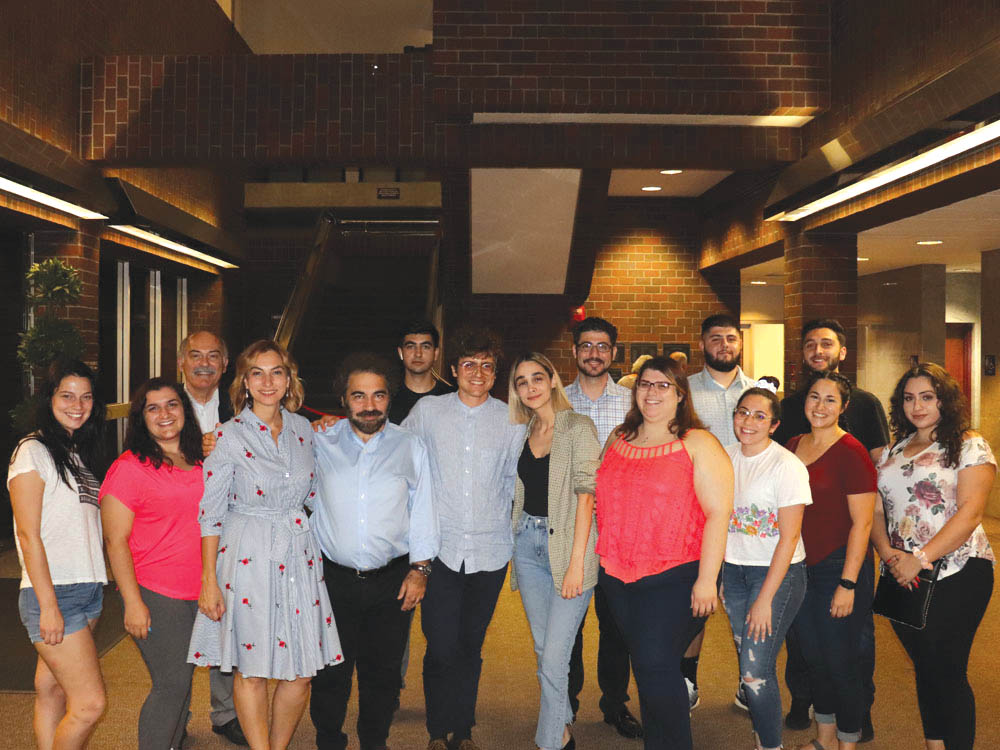
Christine Pambukyan
Staff Writer
After the Armenian Genocide displaced many Armenians from the Ottoman occupied regions of their homeland in 1915, Modern Western Armenian became a language of the Diaspora. As time went on, some Armenians began to forget their native language and assimilated to English, French, German, or other dominant languages of the countries they moved to in order to escape persecution and become successful and well-educated.
In February of 2010, Western Armenian was added to the United Nations Educational, Scientific, and Cultural Organization’s list of endangered languages, which deemed the language as “definitely endangered” in its “Atlas of World’s Languages in Danger.”
On Friday, September 7, 2019, at 7:30PM, four scholars spoke about their contributions to a recently published book, Western Armenian in the 21st Century: Challenges and New Approaches. Western Armenian was co-edited by Bedross Der Matossian and Barlow Der Mugrdechian and published by the Society for Armenian Studies and the Armenian Series of The Press at California State University, Fresno in 2018.
Dr. Hagop Gulludjian, professor of Modern Western Armenian at UCLA, began the evening by discussing the subjects of language vitality of Eastern and Western Armenian and creative literacy within the diaspora. Through his research, Dr. Gulludjian found that only 5.4 percent of the 122,000 Armenians in California are learning Armenian, although many more Armenians have the financial means to go to Armenian schools. This statistic pales in comparison to the Jewish community, where 48 percent of the student population attends Jewish school.
Dr. Gulludjian then explained the rubric used to deem Western Armenian as endangered. Based on his research, he found that for the seven factors of the Language Vitality Test, Armenian fell low on the scale, receiving “endangered,” “dwindling domains,” or “forced assimilation.” Part of the reason for Western Armenian’s endangerment roots back to 1980, when the priority of the diaspora shifted from cultural survival to genocide recognition and assistance of their homeland. At this time, language policies disappeared, and schools began to focus on regulations and standards instead of what kind of scholar they wished to create through their programs. Dr. Gulludjian believes that in order to keep Western Armenian from becoming extinct, we must teach scholars literacy in Armenian, allowing them to produce Armenian works themselves.
Next, Dr. Shushan Karapetian, Deputy Director of the USC Institute of Armenian Studies, discussed her award-winning dissertation of 2015 titled, “Eastern Armenian Speakers as Potential Western Armenian Learners: Reflections on Second Dialect Acquisition,” where she conducted a case study on the Armenians of Los Angeles, California. In her research, Dr. Karapetian found that there is a growing population of non-heritage speakers that are educated and dominant in English and often seek higher knowledge of Armenian in college. She also found that when Armenians learn a new dialect, they go through the acquisitional approach of lexical learning, where they either learn words for the same referent or learn different referents for a known word.
Dr. Karapetian believes that when teachers and family members poke fun at or alienate students when they make mistakes, it speeds up the shift to English in the Diaspora and pushes Western Armenian into extinction. We should be encouraging and inclusive instead.
Jesse Siragan Arlen, a Western Armenian teacher at a Los Angeles Sunday school, and also a poet and a doctoral student, introduced the “Where are Your Keys?” method of teaching language as a tool for Western Armenian. This interactive method, developed by Evan Gardner in 2005, helped revive endangered languages of the Native Americans and Latin. It involves using only sign language and the language being learned within an inclusive environment. Arlen used this approach to teach Armenian to his Sunday school students and found that their confidence increased, and they accomplished more than they did in previous classes. Arlen encourages teachers to learn and use the “Where are Your Keys?” method, in order to make learning Armenian a more positive, productive, and encouraging experience.
UCLA graduate and Armenian poet and author Elizabeth Mkhitarian discussed her study of creative writing in heritage and language instruction titled, “While I make a poem, I’m being made by poetry.” As she studied for her bachelor’s degree in Armenian studies, she took a class that taught Armenian through the “Hagop Gulludjian Method” of creating poetry to learn a language. For her study, she had a qualitative approach when interviewing students about their experiences in Armenian language classes and how it has affected their self-esteem and fluency in Armenian. Mkhitaryan found that because some teachers could be dismissive when their students spoke a dialect other than Eastern Armenian, some students felt discouraged and came to the conclusion that Armenian, their native language, was not for them. She also found that students who were encouraged to create in order to learn Armenian had a more successful and enjoyable experience.
After listening to this lecture, I realized how lucky I am to have Professor Barlow Der Mugrdechian as an Armenian language and Armenian Studies professor. He is encouraging, understanding, and patient. He accommodates for all learning styles while teaching Modern Western Armenian with consideration of students who have a background of Modern Eastern Armenian and other dialects.
Professor Der Mugrdechian always has a reassuring and inclusive attitude during his language classes. Due to his efforts toward keeping Modern Western Armenian alive in Fresno, I am able to express myself in my native language and hopefully pass on what I have learned to my children one day.
Attendees of the lecture were able to purchase copies of the book as they interacted with the contributors of the publication and enjoyed delicious hors d’oeuvres after the lecture. The book itself is written in both English and Modern Western Armenian and is available for purchase through Amazon.
 Hye Sharzhoom Armenian Action
Hye Sharzhoom Armenian Action